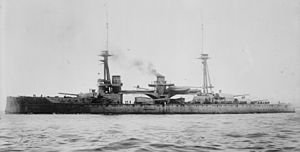 Neptune before 1914
| |
| Class overview | |
|---|---|
| Operators | |
| Preceded by | St Vincent class |
| Succeeded by | Colossus class |
| Completed | 1 |
| Scrapped | 1 |
| History | |
| Name | Neptune |
| Namesake | Neptune |
| Ordered | 14 December 1908 |
| Builder | HM Dockyard, Portsmouth |
| Laid down | 19 January 1909 |
| Launched | 30 September 1909 |
| Completed | January 1911 |
| Commissioned | 11 January 1911 |
| Out of service | November 1921 |
| Fate | Sold for scrap, September 1922 |
| General characteristics (as built) | |
| Type | Dreadnought battleship |
| Displacement | 19,680 long tons (20,000 t) (normal) |
| Length | 546 ft (166.4 m) (o/a) |
| Beam | 85 ft (25.9 m) |
| Draught | 28 ft 6 in (8.7 m) |
| Installed power |
|
| Propulsion | 4 × shafts; 2 × steam turbine sets |
| Speed | 21 knots (39 km/h; 24 mph) |
| Range | 6,330 nmi (11,720 km; 7,280 mi) at 10 knots (19 km/h; 12 mph) |
| Complement | 756–813 (1914) |
| Armament |
|
| Armour | |
HMS Neptune was a dreadnought battleship built for the Royal Navy in the first decade of the 20th century, the sole ship of her class. She was the first British battleship to be built with superfiring guns. Shortly after her completion in 1911, she carried out trials of an experimental fire-control director and then became the flagship of the Home Fleet. Neptune became a private ship in early 1914 and was assigned to the 1st Battle Squadron.
The ship became part of the Grand Fleet when it was formed shortly after the beginning of the First World War in August 1914. Aside from participating in the Battle of Jutland in May 1916, and the inconclusive action of 19 August several months later, her service during the war generally consisted of routine patrols and training in the North Sea. Neptune was deemed obsolete after the war and was reduced to reserve before being sold for scrap in 1922 and subsequently broken up.